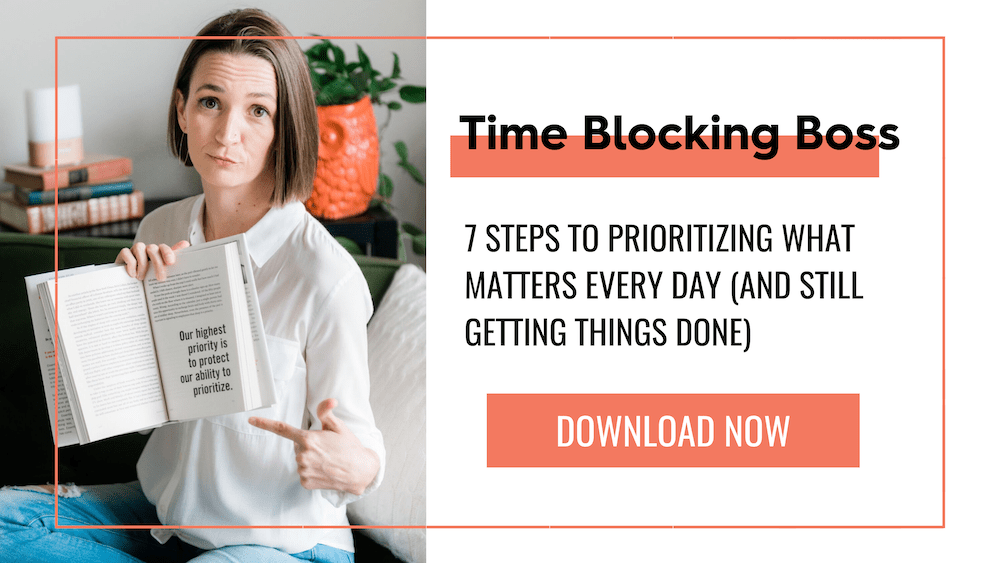If you have ever felt like no matter how hard you work to time block your time, you still cannot seem to get anything done, you’re in the right place. I’m going to walk you through seven strategies to help you time block more effectively and address the common bottlenecks that come up with time blocking so that you are not feeling frustrated or scrambling at the end of your week. Are you ready for this?
Today I’m going to walk you through seven time blocking strategies to help you to get the most done in the least amount of time and still prioritize your biggest priorities, your health, your wellness, your family, your significant other, your goals, your dreams.
Sound good? Make sure that you watch (or read) to the very end of this video because I’m going to actually have a little freebie bonus for you to help you implement and help you start time blocking like a boss.
Watch here or read below.
Now, in last week’s video, I talked about what time blocking is, the importance of it, and a little bit of insight into what it looks like.
If you haven’t already watched that video, be sure to do so because I also shared a little analogy in there that is really going to change the way that you look at your time for the better. I also shared some places that you might get stuck, one of those being quitting on your time blocking attempts too soon because you think it’s not working. In this video, we’re going to solve that.
I’m going to walk you through these strategies, help you solve the common bottlenecks, and help you to get better at this faster so that you can get back to having a life.
Let’s jump right in with strategy or step number one.
STEP NUMBER ONE: CLARITY
You need to have clarity on your priorities, on your long-term goals, and on why these things are important to you.
This step is actually going to tell you how to time block and it’s going to dictate everything you do from here.
If you’re not starting from here, you’re not time blocking correctly. This is also going to help you to stay committed, focused, and motivated to stick to this time blocking and to stick to the schedules and the goals that you’re working on.
What are your priorities?
This should most definitely include your health or well-being, your partner or family, and your big goals. When I say big goals, I’m talking about both your short-term and long-term goals for your life and for your business.
Next, I want you to ask yourself why.
Why are these things important to you? How do these things align with your values and your principles?
Again, step number one is going to tell you where to start first and it’s going to dictate everything else you do, so don’t skip this step.
STEP NUMBER TWO: KNOW YOUR IPAS
No, I do not mean Indian pale ale.
IPAs are income producing activities in your business. These will be different from business to business, so it’s important that you know your IPAs.
Now, when you’re thinking about your income producing activities, I want you to think about a couple of things.
Number one, what are the income producing activities as they relate to those big goals that you outlined in step number one?
Number two, what is the closest to cash IPAs in your business? This is really important to note because a lot of people will prioritize tasks that are important in their business but don’t actually create income. They just maintain it.
You need to know what income-producing activities are the closest to cash. These are the most important ones, so they should be scheduled before you schedule anything else in your business.
Then I also want you to look at weekly income producing activities versus monthly tasks or even quarterly or annually tasks. I say this because it’s very easy to plan out your week but then not leave any space for some of the bigger things that need to be done on a less consistent basis.
Step number one tells you what gets scheduled first.
Step number two tells you what gets scheduled second.

STEP NUMBER THREE: TO REALLY BREAK IT DOWN
You want to break down those big goals into projects, and those projects into tasks, maybe even sub-tasks.
Most people do not reach their goals because their goals aren’t actionable.
Most people do not reach their goals because their goals aren’t actionable. (Tara Wagner) Click To TweetThey’re not specific. They have this big concept of what they want to get done, but no idea the actual step-by-step they need to take in order to get there.
Hear me when I say this. If you do not have a clearly outlined, detailed plan of exactly what you need to do to reach your goals, the likelihood of you ever reaching it is like … It’s like that. It’s like really, really small.
Don’t do that, okay?
Let me give you an example.
Let’s say you’re a photographer and you have a goal of launching a photography course to teach your clients some of the things that you do to help them take better vacation photos.
If you just have this big, giant concept of “I want to create a course,” and you time block three hours to do that, the chances of you getting much done in that three hours is like zero to nil because you don’t know exactly how you’re going to spend that time.
You need to break this down.
- Maybe you want to start off by interviewing 10 of your clients to figure out exactly what they want.
- You need to break that down into sub-tasks and say, “Which 10 clients am I going to interview? What exactly am I going to ask them? When am I going to follow-up with these tasks?”
- Maybe from there, you want to outline the course, and then start writing sections for the course, and then start filming each section of the course. Each of these things is actually its own task with its own sub-task.
Now, when I’m breaking down a project or a goal or I’m helping a client do this, I actually encourage you to look at categories.
When you break your tasks down into categories, it helps it not feel so overwhelming.
When you look at this big, gigantic, messy thing with all of these ideas, but you don’t have it clearly outlined as to what belongs where, the likelihood of you actually getting it done is like … because you’re so overwhelmed, so let’s not go there.
Some ideas of categories might be research. It might be outlining. It might be development. It might be creation mode. It might be marketing. It might be so on and so forth.
Now, you probably will not remember every single task that needs to be written down and that’s okay because you’re going to be able to add to this as you go along and keep it really well organized because you’ve made those categories. You can also use this as a template maybe the next time you’re working on a similar project.
Make sense?
STEP NUMBER FOUR: ASSIGN AN ESTIMATED TIME TO EVERY SINGLE ONE OF YOUR TASKS
Especially in the beginning, you then need to track it to see how much time it actually took.
A lot of people think that I’m crazy for doing this, but to be honest with you, I think it’s crazy how many people don’t do this.
So many people underestimate the time it actually takes to get something done.
We think that we can shoot off an email in three minutes but when you actually time it, it’s more like 10 or 15. Then we get to the end of our day or the end of our week and we can’t figure out where the time went and how we didn’t get anything done.
Track your time.
It is such an amazing tool. It’s going to give you some amazing insight and it’s going to help you to create a more realistic schedule so that you’re not feeling frustrated that nothing’s happening. You’re able to know exactly what you can get done in the time allotted to you.
This is the key to successful time blocking.
Estimate how much time you think it’s going to take you but then, and here’s the kicker, add 50% because, again, we will underestimate.
If you add 50%, if you think something’s going to take 10 minutes, add another five. Maybe even another 10, just to play it safe. If you get it done early, awesome.
It’s two o’clock and you can be done for the day. If you don’t get it done early, great. You’ve had that little bit of extra time and it’s not going to throw your entire day off schedule if something runs late.
I could literally create a whole other video on the benefits of a time audit or time tracking but, suffice to say for now, it’s just going to help you get better and better at this so that you are able to get more and more done in less and less time, and feel really productive, and really happy, and not frustrated, and not overwhelmed.
Sound good?
STEP NUMBER FIVE: PLAN FOR THE UNEXPECTED AND CREATE FLEXIBILITY BUILT INTO YOUR WEEK.
Now, I know people will try to tell you that you can’t plan for the unexpected.
But you CAN and you DO all. the. time.
This is why you have a spare tire in your trunk or you have life insurance or a fire extinguisher because a little bit of planning saves a whole lot of pain.
A little bit of planning saves a whole lot of pain. (Tara Wagner) Click To TweetThings happen.
Your kids are going to get sick, or you’re going to be waiting on other people to finish things that you need to be able to finish what you’re doing, or your computer crashes, or Mercury retrograde happens and you just need to crawl into a hole and stay there for a little while.
Am I right?
How do you actually plan for the unexpected?
Like I said before, that extra 50% that you’re adding into your time estimates is going to make a big difference.
If you have some little distractions coming up, you’re covered. But along with that, I also want you to time block or calendar white space in your week.
Maybe this is every Friday afternoon that you’re just using for catch up. Or the last week of the month that you’re just using, again, for catch up or for follow up or to wrap up the last little bits of a project.
In addition to planning that white space, I also want you to ask yourself two questions.
What obstacles are likely to come up that are going to take me away from my goals?
And, number two, how can I plan for those obstacles right now?
We oftentimes want to blame distractions or our family or all the little things that happen when, really, we can just be prepared for them.
Do a little bit of proactive thinking, try to look ahead, and ask yourself, “What might happen this week or this month to throw me off and what can I do to be prepared?”
Those two little questions, they’re literally life-changing.
Do that anytime you set any goals but most especially every single time that you’re doing your time blocking.
TIME BLOCKING STRATEGY OR STEP NUMBER SIX PROBABLY GOES WITHOUT SAYING, BUT YOU GOT TO ACTUALLY PUT THIS STUFF ON YOUR CALENDAR
I know when you’re first getting started with this, especially with these strategies, it can feel overwhelming.
But Joan Baez said it the best, “Action is the antidote to despair.”
Just start putting some stuff on your calendar. You don’t have to nail it the first week. You just got to start putting it on there and figuring it out.
I want you to take your list and start calendaring everything in this order, your self-care, your family time, the small tasks associated with your big goals and projects, your IPAs, those income producing activities, your white space, any other appointments, everything else in your business, and then things like chores and errands, because, let’s face it, those can be squeezed in just about anywhere.
STEP NUMBER SEVEN: DON’T GIVE UP
We all know challenges will arise.
Let’s just admit that now and let’s admit that there will be a need to make small tweaks along the way.
If we set that healthy, normal expectation now, we’re going to be a whole lot less frustrated in the coming weeks when things aren’t going exactly as we planned. Stop letting problems be in charge.
What I mean by this is so often people just throw up their hands and they’re like, “This just doesn’t work,” or, “This is just the way it is,” or, “I just can’t do this,” and they don’t get creative enough to solve those problems.
Commit to me that you are going to chip away at this.
It takes time to master time.
But each week that you practice this, you’re going to get better and better at it until it’s just second nature.
You’re going to feel good because you’re taking care of your health, your family’s going to be happy, you’re going to be moving in the direction of your real goals, and everything else is still going to be getting done.
I know. Go figure.
FREE TIME BLOCKING BOSS GUIDE!
To help you to do all of this, I’ve created a free guide to walk you through these time blocking strategies!
It will help you make sure you’re time blocking the right things and every step laid out to help you along the way.
It’s called Time Blocking Boss, and you can download for free by clicking the image below or click here to learn more.
WHAT ABOUT YOU, BOSS LADY?
How do you time block your week? What advice do you have for other boss ladies, or what questions do you have for me?
Scroll down to leave your comments!







